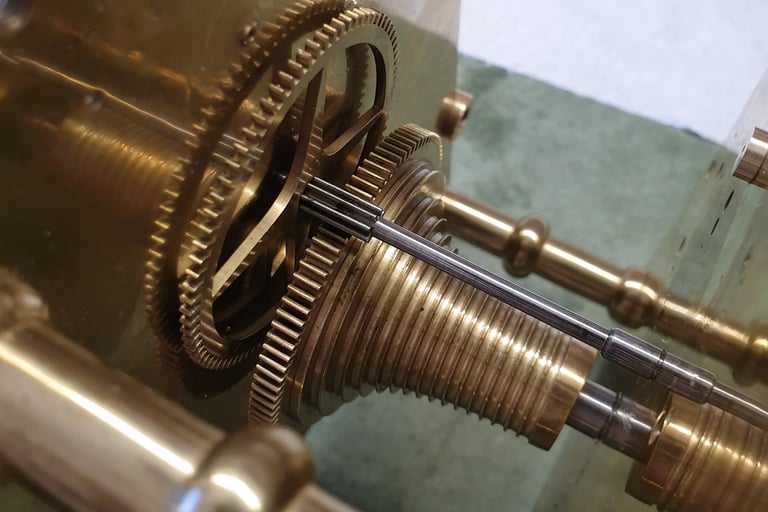David Bond Clock Repairs
Timekeeping characteristics of spring-driven clocks
Timekeeping characteristics of spring driven pendulum clocks with recoil escapements - most mantel clocks, table clocks and some wall and longcase clocks.
The torque available from the mainspring reduces as it unwinds and the rate of the clock reflects this. The clock will run faster during the first half of the winding cycle compared to the second half. This is mainly because of an effect known as "escapement error" which causes the pendulum to swing with a shorter period as more torque is applied to the escapement i.e. the mainspring being wound.
The effect will generally be most pronounced in clocks with short pendulums and large pendulum amplitudes, i.e. mantel clocks. Additionally, clocks with complications such as striking and/chiming work will exhibit an even greater variation in rate. Wall or longcase clocks with long pendulums exhibit far less rate variability.
During long-term testing, the clock error is periodically compared to an NTP (Network Time Protocol) time source, and the clock is then regulated such that there is minimum net error at the end of the winding cycle. Typically, this means that the clock will gain for the first part of the week and lose for the second, but ending up roughly where it started. On the graphs, the ideal error profile is represented by the orange line (adjusted error). It is calculated from the actual errors measured on the clock and adjusted to give a zero net error. Therefore, it represents the best timekeeping this particular clock is capable of achieving.
Graph explanation
The X axis on the graph represents days through the winding cycle and the Y axis is clock error in seconds.
The dark blue line (cumulative error) is the error during the run. The aim is to get the blue line as close to the orange line as possible.
The grey line (daily rate) is the day-to-day error and indicates rate consistency. Typically, this will show minor fluctuations.
The yellow line (series rate) is the overall rate achieved at a given point in the cycle. This will tend to show a constant reduction through the cycle.
Error comparison is not shown.


On the graph above, the test lasted just over seven days. The clock ended the test with a net gain of just over a minute over the period (blue line). If the clock was perfectly regulated so there was zero net gain or loss, the maximum error during the week would be about 72 seconds fast and occurring at just over 4 days (orange line). The daily rate shows a gain for the first five days, with a losing rate thereafter (grey line).
All the above is typical for a mantel clock with a short pendulum that has just been serviced and represents a good result.
Timekeeping characteristics of spring driven clocks with platform escapements - mostly carriage clocks but some mantel clocks.
Most platform escapements are of the “Swiss Lever” or “English” type. These are known as detached escapements where most of the balance amplitude is free from the influence of the pallets and train. This has a huge advantage in that the clock rate is relatively immune to the effects of the reduction in mainspring torque as it unwinds during the winding cycle.
There is still some effect, though. The clock will tend to run faster during the first half of the winding cycle compared to the second half albeit much less than, say, a mantel clock with a short pendulum.
The most common other kind of platform escapement is the “Cylinder”. This is not detached and therefore exhibits a greater variation in rate during the winding cycle.


The above graph is from a carriage clock with a "detached" platform escapement. It clearly shows the benefit of the detached escapement with the maximum error being under four seconds (compared to over 70 for the short pendulum mantel clock). It still shows the characteristic curve, though.
Fusee clocks - English Dial clocks and some large table clocks
The exception to all the above is a type of clock fitted with a "fusee". This a device placed between the mainspring barrel and the rest of the gears in the train and is designed to even out the torque from the mainspring as it unwinds. The image below is of an English Dial clock with the grooved, cone shaped part being the fusee. In the fully wound state, the line from the mainspring barrel is fully wound onto the fusee up to the small diameter end. The torque from the mainspring barrel is thus reduced compared to when fully unwound at the large diameter.


In theory the fusee is perfectly matched to the characteristics of the mainspring such that the torque throughout the winding cycle (almost always a week) will be constant. In practice there may be small variations. Clocks with a fusee should not have their mainsprings replaced if possible as modern springs tend not to match the characteristics of the original carbon steel ones.


The above graph is from an English Dial clock. In spite of it being a spring-driven clock with a recoil escapement, the maximum error over the week was only 10 seconds - a dramatic illustration of how effective a well matched fusee can be.